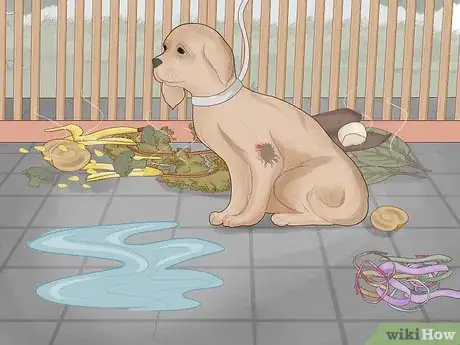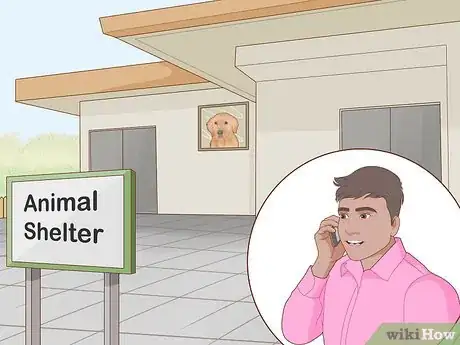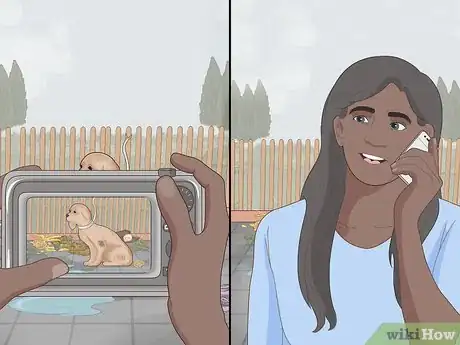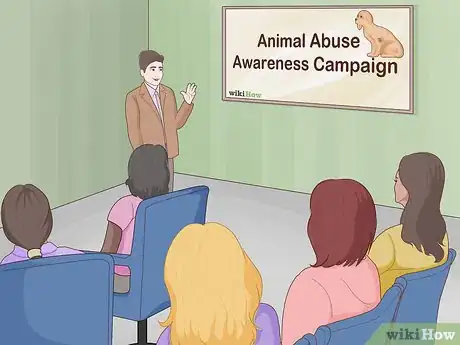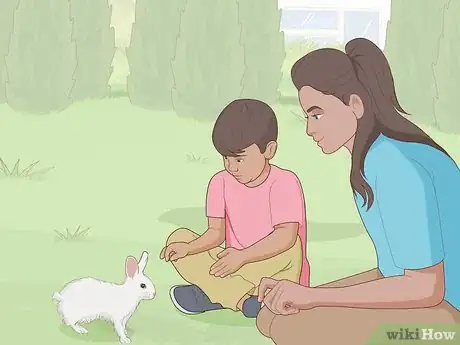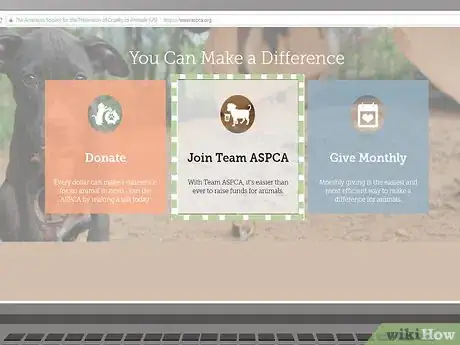This article was co-authored by wikiHow Staff. Our trained team of editors and researchers validate articles for accuracy and comprehensiveness. wikiHow's Content Management Team carefully monitors the work from our editorial staff to ensure that each article is backed by trusted research and meets our high quality standards.
There are 11 references cited in this article, which can be found at the bottom of the page.
This article has been viewed 19,764 times.
Learn more...
Every year, thousands of pets in the US are reported as abused or neglected.[1] Animal abuse, including physical abuse, neglect, and improper care, happens across the world, and can leave animals injured, afraid, or even dead. Concerned individuals can help fight animal abuse, though, on local and national levels. By learning the signs of abuse, volunteering with local organizations, and working with local lawmakers to create stricter policies regarding animal welfare, you can take action to help stop animal abuse starting now.
Steps
Recognizing Animal Cruelty
-
1Read local and state cruelty laws. Laws regarding what constitutes animal cruelty and what can be done about it vary between nations, states or provinces, and local governments. Read your federal, regional, and local laws regarding cruelty.[2]
- Often, such laws can be found online by searching a central government system. If you cannot find any such laws or regulations, try calling a local legal hotline for information on where to find animal-related policies.
-
2Find signs of animal cruelty. Animal cruelty entails more than just violence against an animal. Cruelty can also come in the form of neglect or overwork. Learn everyday signs of animal cruelty, and keep an eye out for them in your community. These may include:[3]
- Collars that are tight enough to cause wounds
- Ongoing injury or illness
- Conditions such as fleas, ticks, hair loss, or scaly skin that is not actively being treated
- Impeded mobility
- Inadequate shelter or being tied up outdoors even in inclement weather
- Kept in unclean area littered with feces, garbage, or potentially harmful objects
- Animal is housed in a kennel too small for them to stand or turn
Advertisement -
3Make contact with your local shelter. Talk to your local animal shelters and rescue organizations about what sorts of cruelty issues they deal with and how to report them. Different organizations may have different criteria and protocol, so knowing who is willing to handle what in advance is important.[4]
- Call your shelter and let them know, “I’m trying to educate myself about preventing animal cruelty. What kind of rescue cases do you work with here and how should I report an abused animal if I encounter one?”
Fighting Animal Abuse Directly
-
1Report any instances of abuse. If you believe an animal in your area is being abused, report the situation right away to your local animal control or humane society offices. If you cannot find the direct number, call your local city offices or, if you’re in the United States, call 311 to get the necessary contact information.[5]
- Record what you observe. Make a note of what actions or symptoms you believe are part of the abuse. If possible, offer to include photo or video in your report.
- Be prepared to testify after you call in an abuse investigation.
-
2Alert authorities but avoid intervening. If you see an act of violence in progress against an animal, call 911 or the local police station right away. Direct intervention is not recommended, but you can have emergency services dispatched immediately if the animal appears to be in a life-threatening situation.
- If the animal is in a truly dangerous situation, such as locked in a car or having an act of violence performed against them, call 911 right away and stay nearby so that you can inform them of the dog's condition. An officer will be dispatched as soon as possible.
- If the animal still needs help but is not in an immediately threatening situation, such as being chained up outside or with a skin condition that is not being treated, report the matter to animal control as soon as possible.
-
3Organize campaigns to inform others. Speakers from humane societies and rescue agencies are generally eager to speak to the public about animal abuse and proper animal care. Call your local humane organization to have a speaker come in and talk about the issues. They often speak and provide literature to:[6] :
- Church groups
- Offices or teams of coworkers
- School groups
- Social clubs
- Campus organizations
- Groups of concerned private citizens such as a neighborhood watch organization
-
4Volunteer with a rescue or shelter. Rescues and shelters are often understaffed and underfunded, and depend heavily on volunteers to ensure that they can provide for the rescue animals. Contact your local shelter or humane organization to ask them about volunteering.[7]
- Call the organization directly and let them know, “I’m interested in volunteering with you. How can I get more information about getting started?” Be prepared to provide them with your availability when you call.
- Be flexible regarding what you are willing to do. Volunteers will do everything from playing with the animals to cleaning up kennels and play yards. This is all necessary work to keep the animals happy and healthy.
- Try to keep a consistent volunteer schedule. You don’t have to work too many hours, but show up for the ones you say you will work. This is necessary for the shelter to function smoothly.
-
5Teach children to respect animals. If you have children or if you work with children, work to teach them respect toward living things. Helping to foster a more mindful future is one of the best hopes for stopping animal abuse long-term.
- Teach children by example. Use kind tones and compassionate words toward your pets and other animals, rather than telling them to “shut up,” or saying other things a child would perceive as hurtful.
- Practice non-violence with small animals from insects to rodents when they find their way into the home. Relocate them without killing or seriously hurting them.
- Bring your child with you for volunteer shifts at local shelters.
- Include books and movies in your child’s entertainment that show kindness and positivity toward animals.
Creating Change in Your Community
-
1Call or write your local representatives. New measures are put forward and laws made because people let their representatives know what issues matter to them. Call or write offices for local representatives, such as senators and congresspersons in the US, to let them know you want to see stricter regulations regarding animal abuse.[8]
- You can find a number of petitions as well as sample letters and phone scripts online to help you organize your thoughts and make a powerful statement.
-
2Schedule a meeting with local legislators. Set up a meeting for just you or you and one or two other concerned citizens to talk with a local legislator. Call their office and let them know, “I would like to set up an appointment to talk about an issue I believe is important to our community.”
- Keep the group you bring small. This keeps meetings more directed and on-track. Appoint a single person to act as spokesperson for the group.[9]
- Prepare talking points in advance. Have any facts or statistics you would like to quote written down and make sure you have a central message such as, “There is not proper legislation in this community to protect animals.” Remember, you will only have about 15 minutes to talk.
- If you are meeting about a specific measure, have your statement about why you support or oppose it ready, citing text from the measure itself to help prove your points.
- Dress professionally and be punctual.
-
3Join an advocacy group. Many humane organizations, as well as national groups like the ASPCA, have advocacy groups or organizations that work to promote animal rights and welfare within local communities. Search online or call your local humane society to find about about advocacy opportunities.[10]
- Join local groups to get information that is tailored to your state or local area.
- Keep your contact information up to date so that the organization is able to easily get in touch with you.
-
4Go vote. When animal rights or animal cruelty measures come up during local and state elections, it is imperative that you go vote in support of animal rights and rehabilitation. Check with your state or county offices to see if you are registered to vote, and if not register immediately.[11]
- Remember, you do not have to vote for every issue on a ballot. If an election involves an animal welfare measure as well as other measures you don’t want to vote on, don’t skip voting, Instead, go and vote specifically for the measure that do concern you.
- Check every election cycle to make sure your voter registration is up to date.
Community Q&A
-
QuestionHow do I make a group to help me stop animal abuse?
 Community AnswerTalk to friends, family or people you know that you think would also like to help and support you in your journey. You could even find people online, but make sure you don't give them your personal information. Once you find a club or group of people, you can make animal awareness websites, put up flyers, keep a lookout for people abusing animals, contact the police if you see any animal abuse or mistreatment in your area, spread awareness, or even do a soapbox or presentation to spread awareness to the public!
Community AnswerTalk to friends, family or people you know that you think would also like to help and support you in your journey. You could even find people online, but make sure you don't give them your personal information. Once you find a club or group of people, you can make animal awareness websites, put up flyers, keep a lookout for people abusing animals, contact the police if you see any animal abuse or mistreatment in your area, spread awareness, or even do a soapbox or presentation to spread awareness to the public!
References
- ↑ http://www.humanesociety.org/issues/abuse_neglect/facts/animal_cruelty_facts_statistics.html
- ↑ http://www.straypetadvocacy.org/PDF/AnimalCrueltyLaws.pdf
- ↑ http://www.aspca.org/take-action/report-animal-cruelty
- ↑ http://www.humanesociety.org/issues/abuse_neglect/tips/cruelty_action.html
- ↑ https://www.cesarsway.com/get-involved/rescue/how-to-stop-animal-cruelty
- ↑ https://www.americanhumane.org/fact-sheet/animal-abuse/
- ↑ http://blog.mysanantonio.com/animals/2012/04/5-easy-ways-you-can-prevent-animal-cruelty/
- ↑ http://aldf.org/resources/advocating-for-animals/working-with-legislators/
- ↑ https://humane-pa.org/take-action/take-action-meet-with-your-state-legislators/

